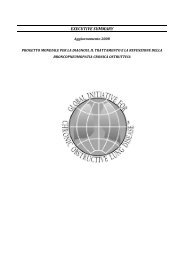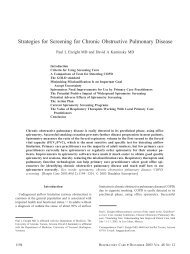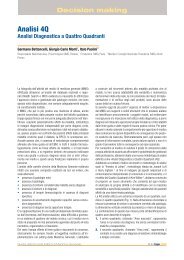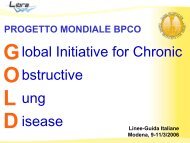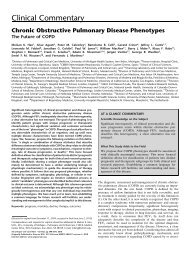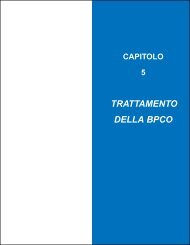Application of Number Needed to Treat (NNT) - GOLD
Application of Number Needed to Treat (NNT) - GOLD
Application of Number Needed to Treat (NNT) - GOLD
You also want an ePaper? Increase the reach of your titles
YUMPU automatically turns print PDFs into web optimized ePapers that Google loves.
<strong>Treat</strong> Respir Med 2006; 5 (2): 79-84<br />
LEADING ARTICLE 1176-3450/06/0002-0079/$39.95/0<br />
© 2006 Adis Data Information BV. All rights reserved.<br />
THIS MANUSCRIPT IS PROVIDED IN CONFIDENCE TO DETERMINE REPRINT INTEREST ONLY AND SHOULD NOT BE DISTRIBUTED<br />
EITHER INTERNALLY OR EXTERNALLY VIA PRINT OR ELECTRONIC MEDIA FOR OTHER THAN THE STATED PURPOSE.<br />
<strong>Application</strong> <strong>of</strong> <strong>Number</strong> <strong>Needed</strong> <strong>to</strong> <strong>Treat</strong> (<strong>NNT</strong>)<br />
as a Measure <strong>of</strong> <strong>Treat</strong>ment Effect in<br />
Respira<strong>to</strong>ry Medicine<br />
Mario Cazzola<br />
Unità di Pneumologia ed Allergologia e Set<strong>to</strong>re di Farmacologia Clinica Respira<strong>to</strong>ria, Dipartimen<strong>to</strong> di Pneumologia,<br />
Ospedale ad Alta Specializzazione A. Cardarelli, Naples, Italy<br />
Abstract<br />
Presentation <strong>of</strong> clinical data can have a pr<strong>of</strong>ound effect on treatment decisions, and there is a need for<br />
measures that are objective, have clinical relevance, and are easily interpreted. Relative risk is <strong>of</strong>ten used <strong>to</strong><br />
summarize treatment comparisons, but does not account for variations in baseline risk pr<strong>of</strong>iles and does not<br />
convey information on absolute sizes <strong>of</strong> treatment effects. Absolute risk reduction gives this information, but the<br />
data are dimensionless and abstract, and lack a direct connection with the clinical environment.<br />
The number needed <strong>to</strong> treat, or <strong>NNT</strong>, has been developed <strong>to</strong> address this issue. <strong>NNT</strong> is the reciprocal <strong>of</strong> the<br />
absolute risk reduction associated with an intervention, and may also be calculated as 100 divided by the absolute<br />
risk reduction expressed as a percentage. The result is the number <strong>of</strong> patients who would have <strong>to</strong> receive<br />
treatment for one <strong>of</strong> them <strong>to</strong> benefit or <strong>to</strong> avoid an adverse outcome over a given period <strong>of</strong> time. Since its<br />
introduction, the concept <strong>of</strong> <strong>NNT</strong> has been expanded <strong>to</strong> include number needed <strong>to</strong> harm (NNH), which illustrates<br />
adverse events or other undesirable outcomes associated with treatment, and the epidemiologic <strong>to</strong>ol <strong>of</strong> number<br />
needed <strong>to</strong> screen.<br />
<strong>NNT</strong> has been used <strong>to</strong> describe treatment effects from many clinical trials. A recent example illustrates<br />
benefit <strong>of</strong> inhaler therapy combining a long-acting β2-agonist (LABA) and corticosteroid for COPD over<br />
treatment with LABA alone. <strong>NNT</strong> has also been extended <strong>to</strong> systematic reviews and meta-analyses, where it has<br />
been used <strong>to</strong> rank different treatments where baseline pr<strong>of</strong>iles, treatment outcomes and time periods under<br />
examination are similar.<br />
<strong>NNT</strong> is therefore a concise and easily unders<strong>to</strong>od <strong>to</strong>ol for quantifying treatment efficacy, particularly when<br />
applying trial results <strong>to</strong> the clinic setting.<br />
It has been clear, since publications in the early <strong>to</strong> mid-1990s, treatment decision on the basis <strong>of</strong> outcomes results reported as<br />
that the results <strong>of</strong> clinical studies, and the method <strong>of</strong> reporting trial relative rather than absolute changes. [2]<br />
results, influence clinicians, policy makers and patients. [1-4] Impor- This has led <strong>to</strong> an increased emphasis on the need for<br />
tantly, perception <strong>of</strong> the magnitude <strong>of</strong> any intervention can be evidence-based prescribing. [5] However, despite ongoing improveinfluenced<br />
markedly by the way in which measurements <strong>of</strong> effect ments in the way information is presented, it is still <strong>of</strong>ten difficult<br />
are reported.<br />
for prescribers and decision makers <strong>to</strong> decide when clinical evidence<br />
As an example, Naylor et al. [4] found that clinicians’ views <strong>of</strong><br />
is strong enough <strong>to</strong> justify a change in practice.<br />
therapeutic effectiveness varied according <strong>to</strong> the endpoint used. The present review therefore examines this issue, focusing on<br />
For example, ratings were lower when results were reported as one particular endpoint – number needed <strong>to</strong> treat (<strong>NNT</strong>) – that has<br />
absolute versus relative differences. [4] In another piece <strong>of</strong> research been developed in an attempt <strong>to</strong> provide an easily interpreted and<br />
published at around the same time, 108 <strong>of</strong> 235 prescribers gave objective measure <strong>of</strong> the effect <strong>of</strong> any medical intervention. The<br />
differing responses <strong>to</strong> a questionnaire when research results were review includes an example <strong>of</strong> the application <strong>of</strong> this measure in<br />
presented in two different ways, and 90% <strong>of</strong> the 108 prescribers patients with COPD in order <strong>to</strong> demonstrate how <strong>NNT</strong> can be used<br />
indicated that they would be more strongly inclined <strong>to</strong> arrive at a <strong>to</strong> assist clinical decision making.
80 Cazzola<br />
THIS MANUSCRIPT IS PROVIDED IN CONFIDENCE TO DETERMINE REPRINT INTEREST ONLY AND SHOULD NOT BE DISTRIBUTED<br />
EITHER INTERNALLY OR EXTERNALLY VIA PRINT OR ELECTRONIC MEDIA FOR OTHER THAN THE STATED PURPOSE.<br />
1. Interpreting Clinical Trial Results intervention is identical in both high- and low-risk groups (25%),<br />
the absolute risk reduction is considerably higher in the high-risk<br />
Absolute and relative risk reductions are used extensively <strong>to</strong> (10%) than in the low-risk (2.5%) group.<br />
summarize the effects <strong>of</strong> treatment in clinical trials (table I). In a While relative risk reduction can provide a basis for balancing<br />
parallel-group study, for instance, the relative risk, or the risk <strong>of</strong> an benefits and drawbacks <strong>of</strong> therapy, it should be accompanied by an<br />
event in the treatment group relative <strong>to</strong> that in the control group, is estimate <strong>of</strong> baseline or untreated risk in individual patients, and<br />
defined as the ratio <strong>of</strong> the risks in the two treatment groups (i.e. the may be subject <strong>to</strong> differences in interpretation. Absolute risk, as<br />
probability <strong>of</strong> an event in the active treatment group divided by the<br />
probability in the control group). [6] Although this concept is<br />
straightforward and easily unders<strong>to</strong>od, it may not give a clinically<br />
meaningful illustration <strong>of</strong> the difference between treatments, as the<br />
value attached <strong>to</strong> any change will be the same regardless <strong>of</strong> the<br />
baseline severity <strong>of</strong> disease (see McQuay and Moore [7] and Barratt<br />
et al. [8] for further details).<br />
A comparison can also be expressed in terms <strong>of</strong> the relative risk<br />
reduction, which is the difference in event rates between the two<br />
treatment groups (usually constant across groups with different<br />
risks). This measure is obtained by subtracting the relative risk<br />
from 1, and is therefore the ratio between the decrease in risk in the<br />
group <strong>of</strong> interest and the risk in the control or compara<strong>to</strong>r group. It<br />
is worth noting at this point that although relative risk and relative<br />
risk reduction give a good quantitative illustration <strong>of</strong> clinical effect<br />
in proportional terms, they do not tell practitioners anything about<br />
effect sizes on an absolute scale. [7]<br />
Although absolute risk conveys little information on proportional<br />
effects, it is a much better indica<strong>to</strong>r <strong>of</strong> whether an interven-<br />
tion has effects that are likely <strong>to</strong> be clinically meaningful. Its chief<br />
disadvantage is that it is a dimensionless and abstract number that<br />
lacks a direct connection with the particular clinical situation. [7]<br />
Absolute risk reduction, or risk difference, is an important alterna-<br />
tive expression <strong>of</strong> comparative results, and is simply the difference<br />
in event rates between groups. [8] These concepts are illustrated in<br />
figure 1, where an example is used <strong>of</strong> a hypothetical trial in which<br />
interventions are being compared in two groups <strong>of</strong> patients (high-<br />
and low-risk groups). While the relative risk reduction for the<br />
Table I. Definitions <strong>of</strong> measures used <strong>to</strong> report outcomes in clinical trials [8]<br />
Measure<br />
Absolute risk<br />
reduction<br />
Relative risk<br />
reduction<br />
<strong>Number</strong> needed <strong>to</strong><br />
treat<br />
<strong>Number</strong> needed <strong>to</strong><br />
harm<br />
Definition<br />
The arithmetic difference between two event<br />
rates<br />
The difference in event rates between two<br />
groups expressed as a proportion <strong>of</strong> the event<br />
rate in the untreated group<br />
The inverse <strong>of</strong> absolute risk reduction, or the<br />
number <strong>of</strong> patients who would have <strong>to</strong> receive<br />
treatment for one <strong>of</strong> them <strong>to</strong> benefit<br />
The inverse <strong>of</strong> absolute risk reduction, or the<br />
number <strong>of</strong> patients who would have <strong>to</strong> receive<br />
treatment for one <strong>of</strong> them <strong>to</strong> experience an<br />
adverse outcome<br />
already stated, lacks a direct connection with the clinical setting.<br />
Neither <strong>of</strong> these measures aid clinical decision making. <strong>NNT</strong><br />
provides a means <strong>of</strong> achieving this end.<br />
2. <strong>Number</strong> <strong>Needed</strong> <strong>to</strong> <strong>Treat</strong> (<strong>NNT</strong>)<br />
<strong>NNT</strong> is the reciprocal <strong>of</strong> the absolute risk reduction (expressed<br />
as a proportion) associated with the treatment or intervention<br />
under examination. [9] Thus, <strong>NNT</strong> is the number <strong>of</strong> patients who<br />
would have <strong>to</strong> receive treatment in order for one individual <strong>to</strong><br />
benefit from treatment or <strong>to</strong> avoid an adverse outcome over a<br />
given period <strong>of</strong> time.<br />
As an example, where <strong>NNT</strong> = 10:<br />
• treatment has <strong>to</strong> be given <strong>to</strong> 10 patients for improvement/<br />
prevention <strong>of</strong> adverse outcome in one; or<br />
• each patient who receives treatment has a 1 in 10 chance <strong>of</strong><br />
benefiting from treatment.<br />
Table II shows how <strong>NNT</strong> is calculated from absolute risk<br />
reduction (as illustrated for the example in figure 1) in high- and<br />
low-risk patients. Only 10 patients in the high-risk group need <strong>to</strong><br />
receive the intervention for a benefit <strong>to</strong> be seen in one <strong>of</strong> them,<br />
whereas this number rises <strong>to</strong> 40 in the low-risk group. This<br />
distinction is not evident from relative risk (figure 1); both groups<br />
have reductions in risk relative <strong>to</strong> control <strong>of</strong> 25%. <strong>NNT</strong> therefore<br />
captures the effect <strong>of</strong> the baseline condition.<br />
<strong>NNT</strong> values approaching 1 indicate that the outcome under<br />
investigation occurs in almost all treated patients and, conversely,<br />
in few patients in the compara<strong>to</strong>r group. In practice, low <strong>NNT</strong><br />
values <strong>of</strong> this magnitude rarely occur, with the possible exception<br />
<strong>of</strong> interventions such as the use <strong>of</strong> antibacterials versus placebo. [7]<br />
While <strong>NNT</strong> values <strong>of</strong> 2–3 indicate that a treatment is quite<br />
effective, some prophylactic interventions with <strong>NNT</strong>s as high as<br />
20–40 may still be regarded as clinically effective. [7]<br />
In addition <strong>to</strong> <strong>NNT</strong>, the number needed <strong>to</strong> harm (NNH) can be<br />
calculated. This is the number <strong>of</strong> patients who would have <strong>to</strong><br />
undergo treatment for one <strong>of</strong> them <strong>to</strong> experience an adverse event.<br />
NNH is determined as 100 divided by the absolute risk increase<br />
expressed as a percentage (or the reciprocal <strong>of</strong> the risk expressed<br />
as a proportion). Several variations <strong>of</strong> <strong>NNT</strong> have also been developed.<br />
These include <strong>NNT</strong> at any time after the start <strong>of</strong> treatment<br />
(see Altman and Andersen [10] ) and the number needed <strong>to</strong> screen<br />
(see Rembold [11] ).<br />
© 2006 Adis Data Information BV. All rights reserved. <strong>Treat</strong> Respir Med 2006; 5 (2)
<strong>NNT</strong> as an Efficacy Measure in Respira<strong>to</strong>ry Medicine 81<br />
THIS MANUSCRIPT IS PROVIDED IN CONFIDENCE TO DETERMINE REPRINT INTEREST ONLY AND SHOULD NOT BE DISTRIBUTED<br />
EITHER INTERNALLY OR EXTERNALLY VIA PRINT OR ELECTRONIC MEDIA FOR OTHER THAN THE STATED PURPOSE.<br />
Risk <strong>of</strong> outcome (%)<br />
45<br />
40<br />
35<br />
30<br />
25<br />
20<br />
15<br />
10<br />
5<br />
0<br />
40<br />
30<br />
High-risk patients<br />
10<br />
Low-risk patients<br />
Control<br />
Intervention<br />
Fig. 1. Event rates and risk reduction. The bars represent the probability <strong>of</strong><br />
an outcome <strong>of</strong> interest in a clinical trial in which a treatment intervention is<br />
being compared with a control group. Results are shown for hypothetical<br />
high- and low-risk patients. Note how the relative risk and relative risk<br />
reduction remain the same for patients at high or low risk at baseline (see<br />
table II). Rates for risk <strong>of</strong> outcome (i.e. event rates) are 40% and 30% in<br />
the control and intervention groups, respectively, in high-risk patients. Corresponding<br />
rates in low-risk patients are 10% and 7.5%, respectively. As<br />
shown in table II, the rate <strong>of</strong> absolute risk reduction in the high-risk group is<br />
40% – 30% = 10% and that in the low-risk group is 10% – 7.5% = 2.5%. In<br />
addition, as shown in table II, the relative risk in the high-risk group is 30%/<br />
40% = 0.75 and the relative risk reduction is 1 – 0.75 = 0.25 (i.e. 25%).<br />
Similarly, for the low-risk group, the relative risk is 7.5%/10% = 0.75 and<br />
the relative risk reduction is 1 – 0.75 = 0.25 (25%).<br />
2.1 Applying Confidence Intervals <strong>to</strong> <strong>NNT</strong><br />
7.5<br />
producing sensible CIs for <strong>NNT</strong> values have been proposed (see<br />
Altman [13] for details).<br />
2.2 Limitations <strong>of</strong> <strong>NNT</strong><br />
<strong>NNT</strong> values are subject <strong>to</strong> some limitations, and care is needed<br />
when applying this method. The <strong>NNT</strong> for any given intervention<br />
should always have a reference or compara<strong>to</strong>r group attached <strong>to</strong> it,<br />
and a particular outcome and period <strong>of</strong> treatment must be defined.<br />
[7] <strong>NNT</strong>s are also treatment specific, and it is not appropriate<br />
<strong>to</strong> use them for comparisons between different diseases, especially<br />
when the outcomes <strong>of</strong> interest differ. For example, an <strong>NNT</strong> <strong>of</strong> 20<br />
for preventing an asthma exacerbation may be valued differently<br />
<strong>to</strong> the same <strong>NNT</strong> value referring <strong>to</strong> prevention <strong>of</strong> COPD exacerbation.<br />
The numerical value is a function <strong>of</strong> disease, intervention,<br />
treatment period and outcome, and <strong>NNT</strong>s should therefore only be<br />
compared directly for different interventions if they refer <strong>to</strong> the<br />
same condition and severity with the same outcome.<br />
2.3 Adjusting <strong>NNT</strong> for Baseline Risk<br />
<strong>NNT</strong> values for a specific intervention depend not only on the<br />
treatment being given but also on baseline risk. So any <strong>NNT</strong> that is<br />
obtained from the literature should be adjusted in accordance with<br />
the risk pr<strong>of</strong>ile <strong>of</strong> the patient(s) being treated. Cook and Sackett [6]<br />
describe a simple method which allows adjustment <strong>of</strong> a trial <strong>NNT</strong><br />
value for the baseline risk <strong>of</strong> an individual patient.<br />
2.4 <strong>Application</strong> <strong>to</strong> Systematic Reviews<br />
As for any point estimate, confidence intervals (CIs) should be<br />
and Meta-Analyses<br />
quoted for <strong>NNT</strong> values whenever possible. The 95% CIs for <strong>NNT</strong><br />
can be simply calculated by inverting the 95% CIs for absolute risk <strong>NNT</strong> is particularly useful where several treatments are as-<br />
reduction. However, when the difference between two treatments sessed for the same outcome measure in patients with the same<br />
is not significant, peculiarities can arise, i.e. negative values or CIs disease condition. <strong>Treat</strong>ments can then be ranked according <strong>to</strong><br />
which include infinity. [12] For example, if the absolute risk reducbalanced<br />
against adverse events and costs, and against patient<br />
their effectiveness <strong>to</strong> aid clinical selection, as long as the <strong>NNT</strong>s are<br />
tion is 10%, with 95% CI <strong>of</strong> –5%, 25%, this gives rise <strong>to</strong> an <strong>NNT</strong><br />
characteristics, expectations and preferences. [7] Systematic re<strong>of</strong><br />
10 with 95% CI <strong>of</strong> –20, 4. The CI <strong>of</strong> –20, 4 will necessarily have<br />
views, including the Cochrane database, <strong>of</strong>ten include <strong>NNT</strong> as a<br />
<strong>to</strong> include infinity, which gives rise <strong>to</strong> two disjointed regions that measure and there are several recent examples <strong>of</strong> this in respira<strong>to</strong>contain<br />
values <strong>of</strong> the <strong>NNT</strong> from 4 <strong>to</strong> infinity and from –20 <strong>to</strong> ry medicine. [12,14-22]<br />
minus infinity. For this reason, <strong>NNT</strong>s are <strong>of</strong>ten reported without There is, however, some controversy attached <strong>to</strong> the use <strong>of</strong><br />
CIs when they are not significant. [7] Alternative techniques for <strong>NNT</strong>s derived from meta-analyses. [23] While <strong>NNT</strong> is recognized as<br />
Table II. The number needed <strong>to</strong> treat (<strong>NNT</strong>) <strong>to</strong> observe a benefit in a single individual in high- and low-risk patients undergoing a hypothetical treatment<br />
intervention (see also figure 1)<br />
Risk category Clinical question Event rate Relative risk Absolute risk <strong>NNT</strong><br />
control intervention reduction reduction<br />
group group<br />
High-risk patients What is the reduction in risk <strong>of</strong> the 40 30 25% or 0.25 10% or 0.1 100/10 or 1/0.1 = 10<br />
event?<br />
Low-risk patients What is the reduction in risk <strong>of</strong> the 10 7.5 25% or 0.25 2.5% or 0.025 100/2.5 or 1/0.025 = 40<br />
event?<br />
© 2006 Adis Data Information BV. All rights reserved. <strong>Treat</strong> Respir Med 2006; 5 (2)
82 Cazzola<br />
THIS MANUSCRIPT IS PROVIDED IN CONFIDENCE TO DETERMINE REPRINT INTEREST ONLY AND SHOULD NOT BE DISTRIBUTED<br />
EITHER INTERNALLY OR EXTERNALLY VIA PRINT OR ELECTRONIC MEDIA FOR OTHER THAN THE STATED PURPOSE.<br />
a useful indica<strong>to</strong>r when used correctly, care is needed <strong>to</strong> specify<br />
settings, time periods, outcomes and baseline risks. [24] Pooled<br />
<strong>NNT</strong>s derived from meta-analyses have been pinpointed as being<br />
potentially misleading because <strong>of</strong> the <strong>of</strong>ten marked variation in<br />
baseline risk between trials. [23,25-27]<br />
Other contribu<strong>to</strong>rs have suggested that systematic reviews<br />
should report efficacy in terms <strong>of</strong> risk reduction, because a relative<br />
risk reduction is independent <strong>of</strong> baseline risk and has the same<br />
value for all treated patients, in contrast <strong>to</strong> <strong>NNT</strong>s. [28] Caution has<br />
also been advised when using 95% CIs, with the suggestion that<br />
the <strong>NNT</strong> should be used only when there is prior knowledge with<br />
which <strong>to</strong> rank the response rates under comparison. [29] Recent data<br />
suggest also that <strong>NNT</strong>s may not be readily unders<strong>to</strong>od by patients,<br />
and might therefore not be suitable for shared treatment decisions.<br />
[30] Further research is needed in<strong>to</strong> these issues <strong>to</strong> address all<br />
concerns.<br />
3. <strong>Application</strong> <strong>of</strong> <strong>NNT</strong> in COPD<br />
An example <strong>of</strong> the practical application <strong>of</strong> <strong>NNT</strong> is provided by<br />
two 12-month, randomized and placebo-controlled double-blind<br />
trials in a combined <strong>to</strong>tal <strong>of</strong> 1834 adult patients with COPD. [31,32]<br />
Patients in both trials had a mean age <strong>of</strong> 64 years, and FEV1 at<br />
baseline <strong>of</strong> 0.99L, or 36% <strong>of</strong> predicted. During the 2-week run-in<br />
period, patients in one trial [32] received an intensification regimen<br />
<strong>of</strong> inhaled formoterol 9µg twice daily and oral prednisolone 30mg<br />
once daily with terbutaline as needed, while in the other trial [31]<br />
patients received terbutaline only as relief medication. After the<br />
2-week run-in period, patients in both studies were randomized <strong>to</strong><br />
treatment (2 inhalations twice daily) with budesonide/formoterol<br />
320/9µg (Symbicort ® 1<br />
), budesonide 400µg alone, formoterol 9µg<br />
alone, or lac<strong>to</strong>se (placebo), for 12 months via Turbuhaler ® dry<br />
powder inhalers (DPIs). Terbutaline 0.5mg was inhaled when<br />
required as rescue medication.<br />
Changes in FEV1 and numbers <strong>of</strong> COPD exacerbations requiring<br />
medical intervention were the primary endpoints in both<br />
studies. Exacerbations were defined as respira<strong>to</strong>ry symp<strong>to</strong>ms re-<br />
quiring treatment with oral corticosteroids and/or antibacterials<br />
and/or hospitalization. The PEF, COPD symp<strong>to</strong>ms, health-related<br />
quality <strong>of</strong> life, use <strong>of</strong> rescue medication and safety were also<br />
assessed.<br />
Both studies showed improvements in peak flow and reduced<br />
frequency <strong>of</strong> exacerbations with combination budesonide/<br />
formoterol when compared with either drug given alone or with<br />
placebo. In both trials, exacerbation rates were reduced significantly<br />
(p < 0.05) by budesonide/formoterol compared with placebo<br />
or formoterol alone (figure 2). In a hazard rate analysis,<br />
Calverley et al. [32] showed that the risk <strong>of</strong> having an exacerbation<br />
while being treated with budesonide/formoterol was reduced by<br />
12-month frequency <strong>of</strong> COPD exacerbations<br />
2.0<br />
1.8<br />
1.6<br />
1.4<br />
1.2<br />
1.0<br />
0.8<br />
0.6<br />
0.4<br />
0.2<br />
0<br />
Budesonide/<br />
formoterol<br />
Szafranski et al.<br />
Calverley et al.<br />
1.59 1.6<br />
1.42 1.38<br />
Budesonide<br />
1.85 1.84 1.87 1.8<br />
Formoterol<br />
Placebo<br />
Fig. 2. Event rates (12-month frequency <strong>of</strong> COPD exacerbations requiring<br />
medical intervention) in two clinical trials comparing inhaled budesonide/<br />
formoterol with either drug alone and with placebo in a combined <strong>to</strong>tal <strong>of</strong><br />
1834 patients. [31,32] In both studies, budesonide/formoterol reduced the<br />
mean 12-month exacerbation rate significantly (p < 0.05) relative <strong>to</strong> placebo<br />
or formoterol alone, with nonsignificant trends relative <strong>to</strong> budesonide<br />
alone.<br />
22.7%, 29.5% and 28.5% relative <strong>to</strong> budesonide alone, formoterol<br />
alone and placebo, respectively.<br />
Calverley et al. [32] also reported that, after the intensification<br />
regimen administered during the run-in period, the improvement<br />
in FEV1 seen during run-in was maintained with budesonide/<br />
formoterol, whereas FEV1 declined markedly in all other groups.<br />
The difference was significant for budesonide/formoterol compared<br />
with placebo (14%; p < 0.001), budesonide alone (11%; p <<br />
0.001) and formoterol alone (5%; p < 0.002). Szafranski et al. [31]<br />
showed a 15% increase in FEV 1 over 12 months with budesonide/<br />
formoterol versus placebo and a 9% increase in FEV1 versus<br />
budesonide alone. Improvements in morning and evening PEF<br />
with budesonide/formoterol relative <strong>to</strong> compara<strong>to</strong>rs were maintained<br />
over 12 months. According <strong>to</strong> Calverley et al., [32] budeso-<br />
nide/formoterol was associated with higher morning PEFs relative<br />
<strong>to</strong> other treatments, and higher evening PEFs when compared with<br />
placebo or budesonide alone. In both studies, budesonide/<br />
formoterol decreased all symp<strong>to</strong>m scores relative <strong>to</strong> placebo and<br />
significantly reduced the use <strong>of</strong> reliever medication relative <strong>to</strong><br />
placebo and budesonide alone in both trials, and also relative <strong>to</strong><br />
formoterol alone in one. [32] Health-related quality <strong>of</strong> life according<br />
<strong>to</strong> the St George’s Respira<strong>to</strong>ry Questionnaire (SGRQ) was in-<br />
creased relative <strong>to</strong> placebo by combination therapy in both studies.<br />
The results <strong>of</strong> these trials are suitable for application <strong>of</strong> <strong>NNT</strong><br />
analysis, because outcomes, treatments, and time periods <strong>of</strong> inves-<br />
tigation were the same in both studies. Moreover, patients in both<br />
studies had similar risk pr<strong>of</strong>iles at baseline: selection criteria<br />
1 The use <strong>of</strong> trade names is for product identification purposes only and does not imply endorsement.<br />
© 2006 Adis Data Information BV. All rights reserved. <strong>Treat</strong> Respir Med 2006; 5 (2)
<strong>NNT</strong> as an Efficacy Measure in Respira<strong>to</strong>ry Medicine 83<br />
THIS MANUSCRIPT IS PROVIDED IN CONFIDENCE TO DETERMINE REPRINT INTEREST ONLY AND SHOULD NOT BE DISTRIBUTED<br />
EITHER INTERNALLY OR EXTERNALLY VIA PRINT OR ELECTRONIC MEDIA FOR OTHER THAN THE STATED PURPOSE.<br />
included COPD symp<strong>to</strong>ms for ≥2 years, a smoking his<strong>to</strong>ry <strong>of</strong> at treatments improved lung function, symp<strong>to</strong>ms and health status,<br />
least 10 pack-years, an FEV1/vital capacity ratio <strong>of</strong> ≤70%, and and reduced the use <strong>of</strong> rescue medication and frequency <strong>of</strong> exacer-<br />
FEV1 <strong>of</strong> ≤50% <strong>of</strong> predicted normal. The mean annual rates <strong>of</strong> bations. The mean annual rates <strong>of</strong> COPD exacerbation were 0.97<br />
exacerbation <strong>of</strong> COPD were similar in both studies, and were with combination therapy, 1.04 with salmeterol alone, 1.05 with<br />
1.42 [31] and 1.38 [32] in patients receiving treatment with budeso- fluticasone alone, and 1.3 with placebo. As shown in table III, this<br />
nide/formoterol. Corresponding rates were 1.59 and 1.60 for resulted in an <strong>NNT</strong> for combination therapy relative <strong>to</strong> salmeterol<br />
budesonide alone, 1.84 and 1.85 for formoterol alone, and 1.87 alone <strong>of</strong> 14 (i.e. 140 patients would need <strong>to</strong> be treated for ten<br />
and 1.80 for placebo (figure 2).<br />
exacerbations <strong>to</strong> be avoided) in 1 year, a value much higher than<br />
Table III shows the effects <strong>of</strong> combination therapy (budesoother<br />
that noted for combination budesonide/formoterol. Expressed annide/formoterol<br />
in this instance) relative <strong>to</strong> the standard therapy <strong>of</strong><br />
way, for every 100 patients treated with budesonide/<br />
long-acting β2-agonist (LABA) alone (formoterol) in terms <strong>of</strong> formoterol for 1 year, between 42 and 47 exacerbations requiring<br />
absolute and relative risk in both studies, and the relationship medical intervention would be prevented versus LABA therapy<br />
between these risks and <strong>NNT</strong>. <strong>NNT</strong> values show that in the study alone, [34] whereas for every 100 patients treated with fluticasone/<br />
<strong>of</strong> Szafranski et al., [31] 24 patients receiving budesonide/formotered<br />
salmeterol for 1 year, only seven exacerbations would be prevent-<br />
ol avoided ten COPD exacerbations requiring medical intervention<br />
versus LABA alone. It should, however, be noted that the <strong>NNT</strong><br />
in 1 year relative <strong>to</strong> the outcome that would have been observed if value relating <strong>to</strong> fluticasone/salmeterol should be interpreted with<br />
the patients had received inhaled formoterol alone. [33,34] In the caution as there was no significant difference between fluticasone/<br />
study <strong>of</strong> Calverley et al., [32] in which patients received an intensificombination<br />
salmeterol and salmeterol alone (p = 0.345 for treatment ratios for<br />
cation regimen before initiating treatment, 21 patients treated with<br />
versus salmeterol therapy). As discussed in section<br />
budesonide/formoterol avoided ten COPD exacerbations requiring 2.1, this means that the hypothetical 95% CI would include infinity<br />
medical intervention in 1 year, relative <strong>to</strong> inhaled formoterol and that an <strong>NNT</strong> <strong>of</strong> infinity should be more appropriately applied<br />
alone. [33,34] These results concur with the effects <strong>of</strong> budesonide/ <strong>to</strong> the difference between the two treatments, which indicates no<br />
formoterol and formoterol alone when compared with placebo. true net clinical benefit <strong>of</strong> fluticasone/salmeterol over salmeterol<br />
Both studies showed a 24% reduction in relative risk with combination<br />
alone.<br />
therapy compared with placebo (p < 0.05), versus a de-<br />
crease in risk <strong>of</strong> only 2% with formoterol alone in the study by 4. Conclusions<br />
Szafranski et al., [31] and an increase in risk <strong>of</strong> 3% with formoterol<br />
alone in the study by Calverley et al. [32]<br />
<strong>NNT</strong> is a meaningful way <strong>of</strong> expressing the benefit (or harm) <strong>of</strong><br />
an active treatment over control. It is concise and easily under-<br />
s<strong>to</strong>od, and conveys both statistical as well as clinical significance.<br />
It is therefore a useful <strong>to</strong>ol for clinical decision making and allows<br />
clinical trial results <strong>to</strong> be applied effectively <strong>to</strong> clinical practice. In<br />
addition, <strong>NNT</strong>s calculated from risks obtained in systematic re-<br />
views and meta-analyses may be useful for ranking treatments for<br />
a given outcome, but must be used with care, particularly in view<br />
<strong>of</strong> the effect varying baseline risk can have on clinical outcomes.<br />
The concept <strong>of</strong> <strong>NNT</strong> has been broadened <strong>to</strong> include NNH and,<br />
There is also a comparison <strong>of</strong> interest <strong>to</strong> be drawn when <strong>NNT</strong>s<br />
are applied <strong>to</strong> the work <strong>of</strong> Calverley and co-workers in patients<br />
with COPD treated with fluticasone/salmeterol (table III). [35] This<br />
so-called TRISTAN (TRial <strong>of</strong> Inhaled STeroids ANd long-acting<br />
beta-agonists) study involved 1465 patients with COPD <strong>of</strong> similar<br />
severity <strong>to</strong> that described in the studies <strong>of</strong> combination budesonide/formoterol<br />
therapy. [31,32] Patients were randomized <strong>to</strong> salmeterol<br />
50µg, fluticasone 500µg, combination salmeterol/fluticasone,<br />
or placebo twice daily via DPI for 12 months. All active<br />
Table III. Absolute and relative risk reductions for exacerbations <strong>of</strong> COPD requiring medical intervention with number needed <strong>to</strong> treat (<strong>NNT</strong>) in three<br />
randomized and double-blind multinational trials<br />
<strong>Treat</strong>ment 12-month frequency <strong>of</strong> exacerbation (mean Absolute risk Relative risk reduction <strong>NNT</strong> Reference<br />
rate per patient per year) reduction (combination versus LABA)<br />
combination therapy LABA only<br />
Budesonide/formoterol 1.42 1.84 0.42 0.23 (23%) 2.4 31<br />
(n = 812)<br />
Budesonide/formoterol 1.38 1.85 0.47 0.25 (25%) 2.1 32<br />
(n = 1022)<br />
Fluticasone/salmeterol 0.97 1.04 0.07 0.067 (6.7%) 14 35<br />
(TRISTAN; n = 1465)<br />
LABA = long-acting β 2-adrenocep<strong>to</strong>r agonist; TRISTAN = Trial <strong>of</strong> Inhaled STeroids ANd long-acting beta-agonists.<br />
© 2006 Adis Data Information BV. All rights reserved. <strong>Treat</strong> Respir Med 2006; 5 (2)
84 Cazzola<br />
THIS MANUSCRIPT IS PROVIDED IN CONFIDENCE TO DETERMINE REPRINT INTEREST ONLY AND SHOULD NOT BE DISTRIBUTED<br />
EITHER INTERNALLY OR EXTERNALLY VIA PRINT OR ELECTRONIC MEDIA FOR OTHER THAN THE STATED PURPOSE.<br />
more recently, the newer measure <strong>of</strong> number needed <strong>to</strong> screen in<br />
epidemiology.<br />
An additional potential benefit <strong>of</strong> <strong>NNT</strong> lies in the learning<br />
process that accompanies its adoption. The principles underlying<br />
calculation <strong>of</strong> <strong>NNT</strong> are easily unders<strong>to</strong>od and link in logically with<br />
the concepts <strong>of</strong> risk and effect <strong>of</strong> outcomes on such risk. Through<br />
the simple background research that is needed, clinicians wishing<br />
<strong>to</strong> apply clinical evidence <strong>to</strong> their practice can benefit from a<br />
greater understanding <strong>of</strong> how the parameters used <strong>to</strong> generate<br />
<strong>NNT</strong>s, relative and absolute risk, are calculated.<br />
As demonstrated in the present review, <strong>NNT</strong> is becoming more<br />
widely adopted in respira<strong>to</strong>ry medicine. Its recent endorsement by<br />
the Consolidated Standards <strong>of</strong> Reporting Trials (CONSORT)<br />
guidelines [36] means that <strong>NNT</strong> is likely <strong>to</strong> be used more frequently<br />
in the medical literature. Physicians are therefore encouraged <strong>to</strong><br />
consider <strong>NNT</strong> data alongside other established measures when<br />
selecting therapeutic interventions for respira<strong>to</strong>ry medicine.<br />
15. Halliday HL. Postnatal steroids and chronic lung disease in the newborn. Paediatr<br />
Respir Rev 2004; 5 Suppl. A: S245-8<br />
16. Stan<strong>to</strong>n WR, Lowe JB, M<strong>of</strong>fatt J, et al. Randomised control trial <strong>of</strong> a smoking<br />
cessation intervention directed at men whose partners are pregnant. Prev Med<br />
2004; 38: 6-9<br />
17. Shah SS, Ohlsson A, Halliday H, et al. Inhaled versus systemic corticosteroids for<br />
preventing chronic lung disease in ventilated very low birth weight preterm<br />
neonates. Cochrane Database Syst Rev 2003; (1): CD002058<br />
18. Ho JJ, Subramaniam P, Henderson-Smart DJ, et al. Continuous distending pressure<br />
for respira<strong>to</strong>ry distress syndrome in preterm infants. Cochrane Database Syst<br />
Rev 2002; (2): CD002271<br />
19. Davis PG, Henderson-Smart DJ. Extubation from low-rate intermittent positive<br />
airways pressure versus extubation after a trial <strong>of</strong> endotracheal continuous<br />
positive airways pressure in intubated preterm infants. Cochrane Database Syst<br />
Rev 2001; (4): CD001078<br />
20. Abramson MJ, Puy RM, Weiner JM. Allergen immunotherapy for asthma. Cochrane<br />
Database Syst Rev 2003; (4): CD001186<br />
21. Powell H, Gibson PG. Inhaled corticosteroid doses in asthma: an evidence-based<br />
approach. Med J Aust 2003; 178: 223-5<br />
22. Rowe BH, Spooner CH, Ducharme FM, et al. Corticosteroids for preventing<br />
relapse following acute exacerbations <strong>of</strong> asthma. Cochrane Database Syst Rev<br />
2001; (1): CD000195<br />
23. Charl<strong>to</strong>n BG. <strong>Number</strong>s needed <strong>to</strong> treat derived from meta-analysis: are an absurdity.<br />
BMJ 1999; 319: 1199<br />
Acknowledgments<br />
24. Smeeth L, Haines A, Ebrahim S. <strong>Number</strong>s needed <strong>to</strong> treat derived from metaanalyses:<br />
sometimes informative, usually misleading. BMJ 1999; 318: 1548-51<br />
25. D’Amico R, Deeks JJ, Altman DG. <strong>Number</strong>s needed <strong>to</strong> treat derived from meta-<br />
The author would like <strong>to</strong> thank AstraZeneca Italy for financial support.<br />
analysis: length <strong>of</strong> follow up is poorly reported. BMJ 1999; 319: 1200<br />
The author would also like <strong>to</strong> thank Adis International Ltd for assistance in the<br />
26. Hopayian K, McGough J. <strong>Number</strong>s needed <strong>to</strong> treat derived from meta-analysis:<br />
preparation <strong>of</strong> this manuscript. The author has received fees for speaking and using patient years may also be misleading. BMJ 1999; 319: 1199-200<br />
consulting and/or financial support for attending meetings from AstraZeneca<br />
27. Moore A, McQuay H. <strong>Number</strong>s needed <strong>to</strong> treat derived from meta analysis: <strong>NNT</strong> is<br />
and GlaxoSmithKline. a <strong>to</strong>ol, <strong>to</strong> be used appropriately. BMJ 1999; 319: 1200<br />
28. Jain BP. <strong>Number</strong> needed <strong>to</strong> treat and relative risk reduction. Ann Intern Med 1998;<br />
128: 72-3<br />
References<br />
29. Lui KJ. A simple logical solution <strong>to</strong> eliminate the limitations <strong>of</strong> using the number<br />
1. Fahey T, Griffiths S, Peters TJ. Evidence based purchasing: understanding results<br />
needed <strong>to</strong> treat. Eval Health Pr<strong>of</strong> 2004; 27: 206-14<br />
<strong>of</strong> clinical trials and systematic reviews. BMJ 1995; 311: 1056-9<br />
30. Halvorsen PA, Kristiansen IS. Decisions on drug therapies by numbers needed <strong>to</strong><br />
2. Forrow L, Taylor WC, Arnold RM. Absolutely relative: how research results are treat: a randomized trial. Arch Intern Med 2005; 165: 1140-6<br />
summarized can affect treatment decisions. Am J Med 1992; 92: 121-4<br />
31. Szafranski W, Cukier A, Ramirez A, et al. Efficacy and safety <strong>of</strong> budesonide/<br />
3. Malenka DJ, Baron JA, Johansen S, et al. The framing effect <strong>of</strong> relative and formoterol in the management <strong>of</strong> chronic obstructive pulmonary disease. Eur<br />
absolute risk. J Gen Intern Med 1993; 8: 543-8 Respir J 2003; 21: 74-81<br />
4. Naylor CD, Chen E, Strauss B. Measured enthusiasm: does the method <strong>of</strong> reporting<br />
32. Calverley PM, Boonsawat W, Cseke Z, et al. Maintenance therapy with budesonide<br />
trial results alter perceptions <strong>of</strong> therapeutic effectiveness? Ann Intern Med<br />
and formoterol in chronic obstructive pulmonary disease. Eur Respir J 2003;<br />
1992; 117: 916-21<br />
22: 912-9<br />
5. Evidence-Based Medicine Working Group. Evidence-based medicine: a new ap-<br />
33. Halpin D, Stahl E, Lundback B, et al. <strong>Treat</strong>ment costs and number needed <strong>to</strong> treat<br />
proach <strong>to</strong> teaching the practice <strong>of</strong> medicine. JAMA 1992; 268: 2420-5<br />
(<strong>NNT</strong>) with budesonide/formoterol <strong>to</strong> avoid one exacerbation <strong>of</strong> COPD [ab-<br />
6. Cook RJ, Sackett DL. The number needed <strong>to</strong> treat: a clinically useful measure <strong>of</strong><br />
stract plus poster]. In: 100 th International Conference <strong>of</strong> the American Thoracic<br />
treatment effect. BMJ 1995; 310: 452-4<br />
Society; 2004 May 21-26; Florida. Am J Respir Crit Care Med 2004 May; 169<br />
7. McQuay HJ, Moore RA. Using numerical results from systematic reviews in Suppl.: A770<br />
clinical practice. Ann Intern Med 1997; 126: 712-20<br />
34. Halpin DM. Evaluating the effectiveness <strong>of</strong> combination therapy <strong>to</strong> prevent COPD<br />
8. Barratt A, Wyer PC, Hatala R, et al. Tips for learners <strong>of</strong> evidence-based medicine:<br />
exacerbations: the value <strong>of</strong> <strong>NNT</strong> analysis. Int J Clin Pract 2005; 59: 1187-94<br />
1. Relative risk reduction, absolute risk reduction and number needed <strong>to</strong> treat.<br />
CMAJ 2004; 171: 353-8<br />
35. Calverley P, Pauwels R, Vestbo J, et al. Combined salmeterol and fluticasone in the<br />
9. Laupacis A, Sackett DL, Roberts RS. An assessment <strong>of</strong> clinically useful measures<br />
treatment <strong>of</strong> chronic obstructive pulmonary disease: a randomised controlled<br />
<strong>of</strong> the consequences <strong>of</strong> treatment. N Engl J Med 1988; 318: 1728-33<br />
trial. Lancet 2003; 361: 449-56<br />
10. Altman DG, Andersen PK. Calculating the number needed <strong>to</strong> treat for trials where 36. Altman DG, Schulz KF, Moher D, et al. The revised CONSORT statement for<br />
the outcome is time <strong>to</strong> an event. BMJ 1999; 319: 1492-5<br />
reporting randomized trials: explanation and elaboration. Ann Intern Med 2001;<br />
11. Rembold CM. <strong>Number</strong> needed <strong>to</strong> screen: development <strong>of</strong> a statistic for disease<br />
134: 663-94<br />
screening. BMJ 1998; 317: 307-12<br />
12. Smucny J, Fahey T, Becker L, et al. Antibiotics for acute bronchitis. Cochrane<br />
Database Syst Rev 2004; (4): CD000245<br />
Correspondence and <strong>of</strong>fprints: Pr<strong>of</strong>. Mario Cazzola, Dipartimen<strong>to</strong> di<br />
13. Altman DG. Confidence intervals for the number needed <strong>to</strong> treat. BMJ 1998; 317:<br />
Pneumologia, Unità di Pneumologia ed Allergologia e Set<strong>to</strong>re di Farmaco-<br />
1309-12<br />
logia Clinica Respira<strong>to</strong>ria, Ospedale ad Alta Specializzazione A. Cardarelli,<br />
14. Reveiz L, Cardona AF, Ospina EG. Antibiotics for acute laryngitis in adults. Via del Parco Margherita 24, 80121 Napoli, Italy.<br />
Cochrane Database Syst Rev 2005 Jan; (1): CD004783<br />
E-mail: mcazzola@qubis<strong>of</strong>t.it<br />
© 2006 Adis Data Information BV. All rights reserved. <strong>Treat</strong> Respir Med 2006; 5 (2)


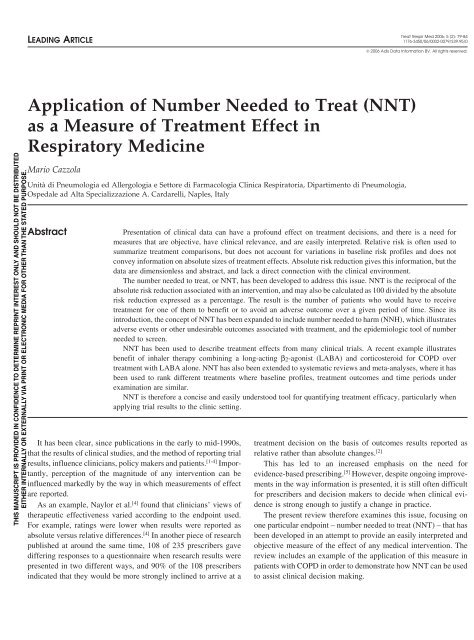
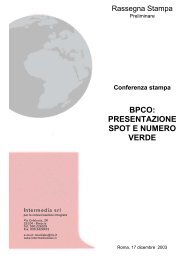
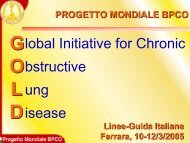
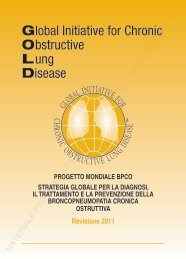
![Di Bari [NO].pdf - GOLD](https://img.yumpu.com/21544924/1/190x143/di-bari-nopdf-gold.jpg?quality=85)

